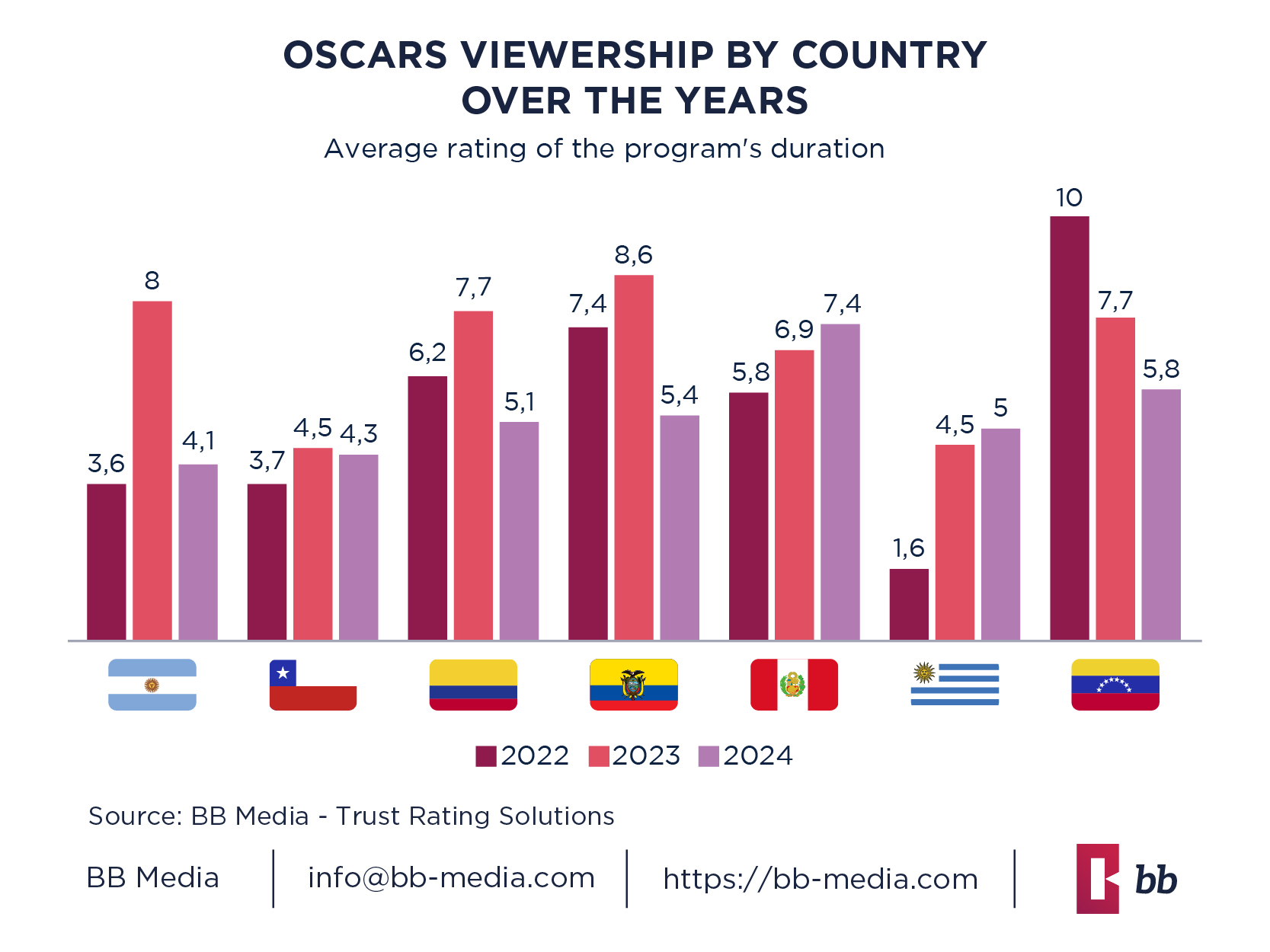The Oscars throw a lifeline to their audiences
What were their intentions and what results did they achieve?The 96th edition of the Oscars took place on Sunday, March 10th, at the Dolby Theater in Los Angeles, hosted by Jimmy Kimmel. For several editions now, the organizers have been striving to regain the levels of viewership they received on television screens one or two decades ago.
Part of this year’s strategy was to diversify the channels through which the ceremony could be accessed, thus maintaining its position in the market. The BB Media team surveyed the main channels and platforms that broadcasted the awards ceremony. Television remains the Oscars’ primary choice, as higher viewership attracts higher advertising prices. Therefore, in linear channels in LATAM, it was available on TNT and TNT Series, while in the United States, it was on TNT and ABC. Regarding streaming, the live event was broadcasted on Max in Argentina, Brazil, Mexico, and the United States. Operators such as DGO, Flow, Izzi GO, and Xview+ also aired it. Users in the United States could access it through YouTube TV, while in Spain, one of the broadcasters was Movistar Plus+. Additionally, social media platforms served as a significant source of information, as many users chose to follow the results through these channels without watching the ceremony.
Furthermore, the Academy made other decisions to prevent audience decline. One of them was to start the ceremony an hour earlier to avoid late-night schedules in certain countries. They also included greater cultural diversity in the nominations: this year, out of the 10 nominees for Best Picture, 3 were foreign productions, one about Native Americans, and another about African Americans. In this way, they hoped that more viewers would feel reflected or have a title to root for. Finally, greater regional diversity was included among the Academy’s over 10,000 members.
It is no news that the United States has been experiencing a constant decline in TV subscription users. BB Media studies indicate that the penetration of pay TV for the fourth quarter of 2023 was 47%, representing a 4% decrease compared to the previous year’s second quarter. Despite this, and after a period of recovery, the broadcast of the awards on linear television sustained similar audience levels to those of the pandemic year, where a peak in home entertainment demand was observed.
Despite the Academy’s efforts to include ethnic productions, such as “American Fiction” (African American) or “Killers of the Flower Moon” (Native American), total social buzz impressions did not reflect a different landscape than usual. BB Media HITS, which analyzes title demand through different factors, identified that the three films that generated the most content from the audience within the United States during the ceremony were: Oppenheimer with +419 million impressions, followed by Barbie with +217 million, and Poor Things with +134 million.
Europe was one of the beneficiaries of the time change, as, on average, the ceremony started at midnight on Monday, March 11th. Additionally, there were changes in broadcasting rights. ITV replaced Sky in Great Britain and attracted a large audience, influenced by the recognition of “The Zone of Interest,” a British production, as Best Foreign Film and Best Sound. Similarly, as in Italy, where the Oscars returned to RAI after years on Sky Italia, a country that also had a nomination for Best Foreign Film for “Io Capitano.”
Regarding Latin America, BB Media shows that in Argentina, the average rating last year, throughout the three-hour show, was 8.02, while in 2024 it was 4.13, implying a 51% decrease. This may be because in 2023, the film “Argentina, 1985” was nominated, whereas in this edition, it did not participate. Although Venezuela has experienced the most significant audience loss in recent editions, this year, along with Colombia and Ecuador, the average decrease was similar. Meanwhile, Chile remained stable. The exception in Latin America was Uruguay, where the audience increased, presumably driven by the country’s interest in the nomination of “La Sociedad de la Nieve” as Best Foreign Film, as it featured Uruguayan actors, and the script was adapted from a local story.

The lifeline thrown by the Oscars to prevent their audience from sinking into the sea of stimuli bore fruit in certain regions, while in others, they will need to seek different strategies to try to regain interest by adapting to the new rules of the game. The organizers’ premeditation, specifically aimed at increasing and retaining the audience, likely played a crucial role in the success of this edition, which will be remembered for the significant progress in the inclusion of diverse cultures and countries.
Sources
BB Media | Trust Rating Solutions
ABOUT BB MEDIA
BB Media is a global Data Science company, specialising in Media and Entertainment for over 37 years. BB Media monitors more than 4,500 streaming services across 250 countries and territories, including their prices, plans, bundles, and commercial offers. In addition, it monitors all movie and series catalogues, including standard metadata. Streaming services, networks, programmers, cable operators, agencies, advertisers, studios, distributors, content apps, and tech companies rely on BB Media’s valuable information and analysis to make strategic decisions.
BB Media is part of Fabric.
ABOUT FABRIC
Fabric is the entertainment industry’s leader in data and operations solutions, empowering broadcasters, studios, distributors, producers, and media organizations to connect people with the content they love. Fabric’s platform combines the best of metadata and supply chain management with powerful media resource and workflow solutions, enabling customers to manage identification, editorial, technical, discovery, and AI-generated metadata with ease. By integrating cutting-edge technology with decades of industry expertise, Fabric streamlines operations, enhances decision-making, and drives efficiency across the entire media supply chain.
